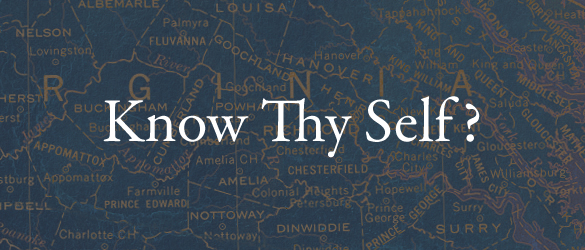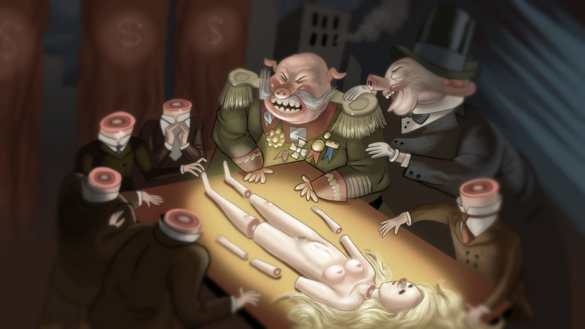A few months ago, I stood in front of a large image of my state of Virginia, red and blue lines running horizontally, vertically, and diagonally, crisscrossing one another like spindly veins on an invigorated human hand. At certain points on these veins were single, isolated words, their lonesomeness aggrandized by the stark white backdrop: “Prudish,” “Unthinkable,” “Freemason,” “Duty,” “Buttercup,” “Alienate,” “Estrogen,” “Kissable,” “Bland.” This particular map of Virginia, formerly hanging in a gallery in Charlottesville, is one of thirty-eight maps of various American states and cities in which artist R. Luke Dubois mapped the identities of 19,095,414 American singles.
“I joined twenty-one dating sites in order to make my own census of the United States in 2010,” writes Dubois in his introduction to his geographical art piece, “A More Perfect Union,” a work that he describes as a “road atlas of the United States, with the names of cities, towns, and neighborhoods replaced with the words people use to describe themselves and those they want to be with.” Dubois chose to define us by what he says is the more humanistic approach, love, an approach that allegedly says more about who we are than the cold figures depicted in the U.S. Census.
But while trying to craft a more accurate picture of us as Americans, Dubois attests to the half-truths inherent in his dating-site based algorithm: “[To join a dating site] You have to provide, in addition to some basic statistics, two pieces of prose: you have to say who you are, and you have to say who you want to be with. In the second piece of writing, you have to tell the truth. In the first, you have to lie.”
“A More Perfect Union” begs various questions about our ability to understand and to represent ourselves: Are our words really the most objective measure of our identities? Should we trust ourselves to express our selves and our needs in the most honest fashion?
D.H. Lawrence warned us: “Never trust the teller. Trust the tale.” As a writer, he realized that artists lack the capacity to accurately represent their own creations, a strange notion considering that the “tale” is a manifestation that issues forth from an artist’s own being. It may be hard for the writer to understand her own work, which may certainly be disconcerting for those who believe that artists set forth to send a coherent message to her viewer or reader.
Beside the artistically inclined segment of the population, non-artists also have trouble truly understanding themselves. The perplexing truth is, people are not good at understanding why they do the things they do. Contrary to what you would assume, instead of acting based on how we feel, we act before we understand how we feel. We feel melancholy because we frown; we don’t frown because we are melancholy. We actually analyze our behaviors in order to understand which emotion we are feeling, oftentimes mistakenly thinking that external reasons, e.g. he kicked me in the foot, are the causes of our anxiety instead of internal factors, e.g., I didn’t sleep enough last night. We get it all wrong. And we are also not very adept at characterizing others’ behaviors. Fritz Heider argued that people are akin to “amateur scientists” who are constantly “trying to understand other people’s behavior by piecing together information until they arrive at a reasonable explanation or cause,” “amateur” being the key word.
Not only do we fail to understand our own actions, but we also cannot seem to identify our emotions, to discern if we are happy, frustrated, angry, or sad. In 1964, Stanley Schachter proposed the two-factor theory of emotion, which stated that when attempting to understand their feelings, people first experience physiological arousal and then attempt to identify or explain that feeling. But problematically, people often assign the most obvious or practical reasons for their emotions, leading the individual to experience a mistaken emotion. In a study by Dutton and Aron (1974), a beautiful woman approached men and asked them to fill out a questionnaire, tearing off a corner of the questionnaire with her phone number written on it, just in case they wanted to know more about the study. In one condition, she accosted them on a 450-foot-long suspension bridge made of wooden planks, a bridge made even more frightening due to the fact that it stretched across a plummeting canyon. In the second condition, the men were sitting comfortably on a bench, relaxing safely in a park. In which scenario did the men call her back the most? The wobbly bridge scenario, of course! The precariously hanging bridge accelerated the men’s heart rates, which in turn led them to mistakenly believe that they had felt some attraction to the woman. Oops.
Clearly we should put less stock in our ability to accurately describe who we are. A combination of a dangling bridge and an accelerated heartrate can lead to a case of false attraction. If we can’t be trusted to describe our own behaviors and emotions, does Dubois’s piece show us anything really truthful about who we are? Isn’t a cold number more objective? Husband. Neurologist. Three Kids. 300,000k/per annum.
And further, is love, that complex, messy, obfuscating system of interaction that Dubois chooses as his descriptor, our most revelatory interest? Do not our religious beliefs, our political views, our preference of chocolate over vanilla, even, demonstrate much more about who we are as people?
Dubois quotes Darby Slick in the accompanying essay to his pieces when he writes, “You better find somebody to love.” The pressure to find somebody can be so overpowering, so influential, that, Dubois suggests, people lie about themselves to seem wittier, happier, kinder, physically fitter. We need companionship to the degree that we will connive, lie about, manipulate our personas. Why trust us to give you an honest opinion of ourselves?
While we would be significantly less inclined to trust what a man says of his emotional intelligence, we would probably be more likely to trust him when he says that he is a registered Democrat. We would trust him to know that much about himself. But considering that the good-on-paper people have the reputation of never being quite as good as their resumes makes them seem, are the facts any better at showing our true selves, our personalities?
For now, I’ll just take Ann Radcliffe’s words to heart: “I never trust people’s assertions, I always judge of them by their actions.”
Sources
Social Psychology, 7th Edition. Pearson/CourseSmart, 09/22/2009. p. 132).
<vbk:PBK9780138144579#page(132)>
http://140.232.1.5/~jlaird/selfperc.html



